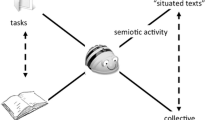Abstract
This paper introduces the language associated with a polygon microworld called PolygonR&D, which has the mathematical crispness of Logo and has the discreteness and simplicity of a Turing machine. In this microworld, polygons serve two purposes: as agents (similar to the turtles in Logo), and as data (landmarks in the plane). Programming the spatial behaviour of polygon agents is achieved by a simple variable-free language. Although limited in the number of instructions, the language allows for complex outcomes such as creation of sophisticated tilings, algorithm visualization, simulations, and even numerical computation. The ease of constructing the variety of examples shown in this paper indicates the microworld’s potential in both secondary and post-secondary education.
Similar content being viewed by others
References
Abbot E.A. (1884). Flatland: A Romance of Many Dimensions. Seeley & Co., Ltd., London
Abelson H., diSessa A. (1981). Turtle geometry: the computer as a medium for exploring mathematics. MIT Press, Cambridge, MA
Blikstein, P., Abrahamson, D. and Wilensky, U. (2005). Netlogo: Where we are, where we’re going. In I. Eisenberg and E. Eisenberg (Eds), Proceedings of the Fourth International Conference for Interaction Design and Children (IDC 2005), Boulder, Colorado
Dewdney A.K. (1989). Computer recreatation: Twodimensional Turing machines and turmites make tracks on a plane. Scientific American 261(3):124–127
Dijkstra E.W. (1972). Notes on structured programming. In: Dahl O.-J., Hoare C.A.R., Dijkstra E.W. (eds) Structured Programming. Academic Press, New York, pp. 1–82
Gajardo A., Goles E. and Moreira A. (2001). Generalized Langton’s ant: Dynamical behavior and complexity. Lecture Notes in Computer Science 2010:259–270
Grünbaum B., Shephard G.C. (1989). Tilings and Patterns: An Introduction. W. H. Freeman and Company, New York
Hopcroft J.E., Ullman J.D. (1979). Introduction to Automata Theory, Languages, and Computation. Addison-Wesley, Reading, Mass
Morey, J. (2005). TileLand. http://www.csd.uwo.ca/∼morey/CogEng/TileLand.html. last, last accessed: July 2005
Morey, J. and Sedig, K. (2004). Using indexedsequential geometric glyphs to explore visual patterns. In Proceedings of Interactive Visualisation and Interaction Technologies (IV&IT 2004). AACE
Papert S. (1980). Mindstorms: Children, Computers, and Powerful Ideas. Basic Books, New York
Papert S. (1987). Computer Criticism vs. Technocentric Thinking. Educational Researcher 16(1):22–30
Penrose R. (1979). Pentaplexity. Mathematical Intelligencer 2:32–37
Peterson I. (1988). The Mathematical Tourist: Snapshots of Modern Mathematics. W. H. Freeman and Company, New York
Rader, C., Cherry, G., Brand, C., Repenning, A. and Lewis, C. (1998). Designing mixed textual and iconic programming languages for novice users. In Visual languages (Symposium on) (pp 187–194). IEEE
Repenning, A. (1993). Agentsheets: A Tool for Building Domain-Oriented Dynamic, Visual Environments. PhD thesis, University of Colorado at Boulder
Resnick M. (1996). Beyond the centralized mindset. Journal of Learning Sciences 5(1):1–22
Resnik M. (1994). Turtles, Termites and Traffic Jams – Explotations in Massively Parallel Mircoworlds. The MIT Press, Cambridge, Massachusetts
Sedig, K., Morey, J. and Chu, B. (2002). Tileland: A microworld for creating mathematical art. In World Conference on Educational Multimedia and Hypermedia 2002 (pp. 1778–1783). AACE
Senechal M. (1995). Quasicrystals and Geometry. Cambridge University Press, Cambridge
Smith, D. C., Cypher, A. and Schmucker, K. (1996). Making programming easier for children. Interactions 3(5):58–67
Travaglini, S. (2003). An Exploratory Study of Interactive Design Using a Tiling Microworld. Master’s thesis, University of Western Ontario
Watt, S. (1998). Syntonicity and the psychology of programming. In J. Domingue and P. Mulholland (Eds), Proceedings of the Tenth Annual Meeting of the Psychology of Programming Interest Group (pp. 75–86)
Weinstein, A. (2001). Groupoids: Unifying internal and external symmetry: A tour through some examples. In Ramsay, A. and Renault, J. (Eds), Groupoids in Analysis, Geometry, and Physics, Contemporary Mathematics (pp. 1–19). American Mathematical Society
Wilensky, U. (2002). Netlogo. http://www.ccl.northwestern.edu/netlogo/. Center for Connected Learning and Computer-Based Modeling, Northwestern University, Evanston, IL.
Wilensky U., Resnick M. (1999). Thinking in levels: A dynamic systems perspective to making sense of the world. Journal of Science Education and Technology 8(1):3–18
Author information
Authors and Affiliations
Corresponding author
Additional information
An erratum to this article can be found at http://dx.doi.org/10.1007/s10758-006-9108-5
Rights and permissions
About this article
Cite this article
Morey, J. Programming in Polygon R&D: Explorations with a Spatial Language II. Int J Comput Math Learning 11, 147–175 (2006). https://doi.org/10.1007/s10758-006-0004-9
Published:
Issue Date:
DOI: https://doi.org/10.1007/s10758-006-0004-9




